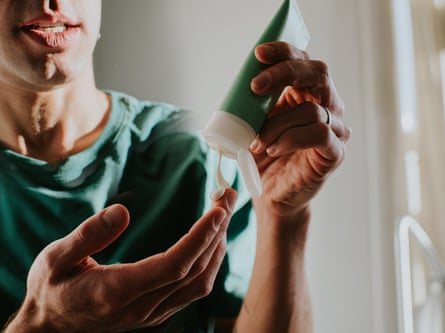Australia may be experiencing an unseasonably warm winter, but whenever temperatures drop and heaters switch on, our skin is likely to require a bit of extra care.
“Your skin doesn’t necessarily behave the same way year-round and you need to modify your skincare,” says dermatologist Dr Shreya Andric. “In winter, the air is generally drier and we spend more time inside with heaters.
“Skin can become more flaky and potentially irritated if we continue to treat it the same as we would in summer.”

One of the biggest problems comes not from cold, but the heaters we use to combat it, says Dr Natasha Cook, a specialist dermatologist. Sitting directly in front of a heater or open fire should be avoided “at all costs”, she says. Not only are they drying, but they damage the “very important barrier layer” of our skin.
Fortunately, if you’re already suffering from dryness or irritation, you only need to make small modifications to your usual skincare routine. Dr Yalda Jamali, a cosmetic doctor, suggests a thicker moisturiser than you’d use in summer, serums containing hyaluronic acid for extra hydration, and a gentle chemical exfoliant once or twice a week to help lift any flakiness that may develop.
“Don’t be scared of exfoliating in winter,” Jamali says. “The skin still would benefit from exfoliation and products can penetrate better on exfoliated skin, but maybe opt for more gentle ingredients such as PHAs [polyhydroxy acids]: lactobionic acid and gluconolactone.”
Andric’s preference is to use “fewer but more effective” products. “Cleanser, moisturiser and sunscreen are your basics,” she says. “Based on your skin type, you can build from there. If your skin starts to feel irritated, pull it back and start again, introducing one active ingredient at a time.”
Foam is not your friend
Basics are not created equal and Cook recommends tossing any products that are foaming or soap-like – whether they’re for your face or body.
“These are filled with surfactants that will strip the skin of hydration and break down your protective barrier layer,” she says. She recommends soap-free and non-foaming cleansers and “thicker” moisturisers applied at least twice a day.
“Pick creams over lotions,” she says. “Humectants and occlusives are ingredients in moisturisers that hold moisture into your skin. Think glycerin, shea butter, cocoglycerides, botanical oils [and] lanolin, for example.”
Work with your skin type
“If you have oily or acne-prone skin, then you should use a beta-hydroxy acid like salicylic acid for your chemical exfoliant,” says Andric. She also suggests choosing an oil-free, non-comedogenic (pore-blocking) moisturiser.
“If you have sensitive skin, choose products that are unfragranced and contain fewer ingredients. Vitamin B3, AKA niacinamide, is excellent for reducing inflammation and restoring skin barrier.”

Andric says those with dry skin should look for products with glycerol, hyaluronic acid and ceramides, which will attract moisture and repair the skin barrier.
“Drier skin or eczema-prone types will struggle more, so they will need thicker ointment–like moisturisers and potentially apply several times a day,” Cook advises. “Dry skin is more than just how it feels or looks. Dry skin cannot function properly and is a cause of a lot of skin issues [like] dermatitis, rosacea [and] rashes.”
after newsletter promotion
Do not skip sunscreen
“Many people feel they don’t need to use a sunscreen in winter, but in Australia the UV index is often 3 or higher even in the cooler months,” Jamali says. “If it is, then you need to be using your SPF30+ or higher sunscreen on a daily basis.”
Don’t neglect your hands and body
Although she recognises “it’s cruel”, Andric suggests sticking to cool, three-to-five-minute showers if you have dry skin, even in the depths of winter. Using a soap-free body wash can also help.
And if you are having a bath, Cook says: “Add in oil to hydrate at the same time.”

Once you are out of the bath or shower, Andric suggests patting yourself dry, rather than rubbing, then applying moisturiser top to toe.
Cook agrees: “Put moisturiser on straight away, before the skin dehydrates.”
As for the skin on your hands, Andric says “soap and water [are] often worse for the skin than alcohol hand gels”. While handwashing is essential for hygiene, she recommends using a soap-free wash where possible and ideally applying a moisturiser after every handwash.
“Use gloves when cooking [and] cleaning so that you’re washing the gloves in between steps, rather than your skin,” she adds.

Jamali says overnight hydrating sleeping masks are “a great easy addition” to your night-time routine and recommends topical retinoids to help increase skin cell turnover. “Some prefer to use retinoid products in the winter as this ingredient usually makes our skin more photosensitive,” she says.
For the same reason, “winter is the perfect time to have in-clinic skin treatments such as laser, needling and chemical peels”, Jamali says. “This is because in-clinic skin treatments tend to make us more photosensitive and, if exposed to high levels of UV, we may suffer post-inflammatory hyperpigmentation following treatments.”
But, she cautions, all of these treatments make wearing sunscreen even more paramount and should only be undertaken after consultation with a dermatologist or cosmetic doctor.
Stay connected with us on social media platform for instant update click here to join our Twitter, & Facebook
We are now on Telegram. Click here to join our channel (@TechiUpdate) and stay updated with the latest Technology headlines.
For all the latest Education News Click Here
